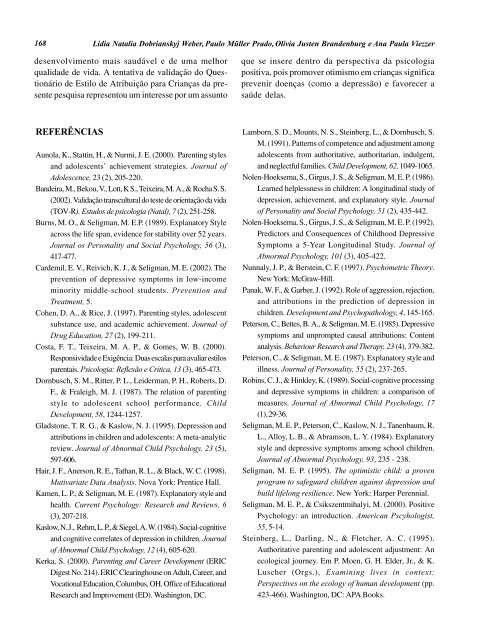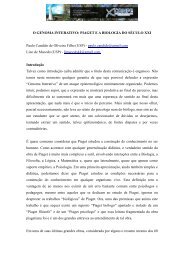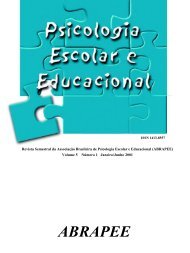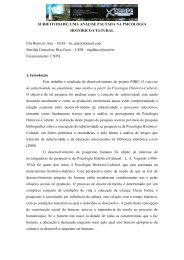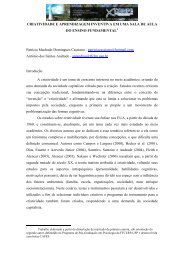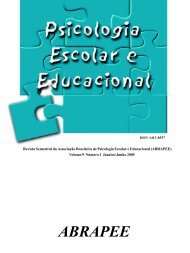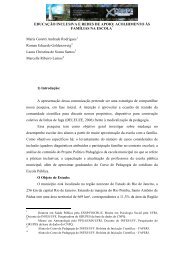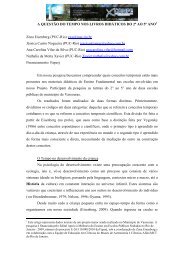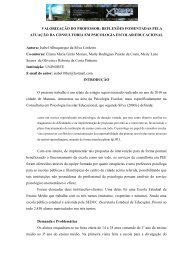168 Lidia Natalia Dobrianskyj Weber, Paulo Müller Prado, Olivia Justen Brandenburg e Ana Paula Viezzerde<strong>se</strong>nvolvimento mais saudável e de uma melhorqualidade de vida. A tentativa de validação do Questionáriode Estilo de Atribuição para Crianças da pre<strong>se</strong>ntepesquisa repre<strong>se</strong>nt<strong>ou</strong> um interes<strong>se</strong> por um assuntoque <strong>se</strong> in<strong>se</strong>re dentro da perspectiva da psicologiapositiva, pois promover otimismo em crianças significaprevenir doenças (como a depressão) e favorecer asaúde delas.REFERÊNCIASAunola, K., Stattin, H., & Nurmi, J. E. (2000). Parenting stylesand adolescents’ achievement strategies. J<strong>ou</strong>rnal ofAdolescence, 23 (2), 205-220.Bandeira, M., Bek<strong>ou</strong>, V., Lott, K S., Teixeira, M. A., & Rocha S. S.(2002). Validação transcultural do teste de orientação da vida(TOV-R). Estudos de psicologia (Natal), 7 (2), 251-258.Burns, M. O., & Seligman, M. E.P. (1989). Explanatory Styleacross the life span, evidence for stability over 52 years.J<strong>ou</strong>rnal os Personality and Social Psychology, 56 (3),417-477.Cardemil, E. V., Reivich, K. J., & Seligman, M. E. (2002). Theprevention of depressive symptoms in low-incomeminority middle-school students. Prevention andTreatment, 5.Cohen, D. A., & Rice, J. (1997). Parenting styles, adolescentsubstance u<strong>se</strong>, and academic achievement. J<strong>ou</strong>rnal ofDrug Education, 27 (2), 199-211.Costa, F. T., Teixeira, M. A. P., & Gomes, W. B. (2000).Responsividade e Exigência: Duas escalas para avaliar estilosparentais. Psicologia: Reflexão e Crítica, 13 (3), 465-473.Dornbusch, S. M., Ritter, P. L., Leiderman, P. H., Roberts, D.F., & Fraleigh, M. J. (1987). The relation of parentingstyle to adolescent school performance. ChildDevelopment, 58, 1244-1257.Gladstone, T. R. G., & Kaslow, N. J. (1995). Depression andattributions in children and adolescents: A meta-analyticreview. J<strong>ou</strong>rnal of Abnormal Child Psychology, 23 (5),597-606.Hair, J. F., Anerson, R. E., Tathan, R. L., & Black, W. C. (1998).Mutivariate Data Analysis. Nova York: Prentice Hall.Kamen, L. P., & Seligman, M. E. (1987). Explanatory style andhealth. Current Psychology: Re<strong>se</strong>arch and Reviews, 6(3), 207-218.Kaslow, N. J., Rehm, L. P., & Siegel, A. W. (1984). Social-cognitiveand cognitive correlates of depression in children. J<strong>ou</strong>rnalof Abnormal Child Psychology, 12 (4), 605-620.Kerka, S. (2000). Parenting and Career Development (ERICDigest No. 214). ERIC Clearingh<strong>ou</strong><strong>se</strong> on Adult, Career, andVocational Education, Columbus, OH. Office of EducationalRe<strong>se</strong>arch and Improvement (ED). Washington, DC.Lamborn, S. D., M<strong>ou</strong>nts, N. S., Steinberg, L., & Dornbusch, S.M. (1991). Patterns of competence and adjustment amongadolescents from authoritative, authoritarian, indulgent,and neglectful families. Child Development, 62, 1049-1065.Nolen-Hoek<strong>se</strong>ma, S., Girgus, J. S., & Seligman, M. E. P. (1986).Learned helplessness in children: A longitudinal study ofdepression, achievement, and explanatory style. J<strong>ou</strong>rnalof Personality and Social Psychology, 51 (2), 435-442.Nolen-Hoek<strong>se</strong>ma, S., Girgus, J. S., & Seligman, M. E. P. (1992).Predictors and Con<strong>se</strong>quences of Childhood DepressiveSymptoms a 5-Year Longitudinal Study. J<strong>ou</strong>rnal ofAbnormal Psychology, 101 (3), 405-422.Nunnaly, J. P., & Berstein, C. F. (1997). Psychometric Theory.New York: McGraw-Hill.Panak, W. F., & Garber, J. (1992). Role of aggression, rejection,and attributions in the prediction of depression inchildren. Development and Psychopathology, 4, 145-165.Peterson, C., Bettes, B. A., & Seligman, M. E. (1985). Depressivesymptoms and unprompted causal attributions: Contentanalysis. Behavi<strong>ou</strong>r Re<strong>se</strong>arch and Therapy, 23 (4), 379-382.Peterson, C., & Seligman, M. E. (1987). Explanatory style andillness. J<strong>ou</strong>rnal of Personality, 55 (2), 237-265.Robins, C. J., & Hinkley, K. (1989). Social-cognitive processingand depressive symptoms in children: a comparison ofmeasures. J<strong>ou</strong>rnal of Abnormal Child Psychology, 17(1), 29-36.Seligman, M. E. P., Peterson, C., Kaslow, N. J., Tanenbaum, R.L., Alloy, L. B., & Abramson, L. Y. (1984). Explanatorystyle and depressive symptoms among school children.J<strong>ou</strong>rnal of Abnormal Psychology, 93, 235 - 238.Seligman, M. E. P. (1995). The optimistic child: a provenprogram to safeguard children against depression andbuild lifelong resilience. New York: Harper Perennial.Seligman, M. E. P., & Csikszentmihalyi, M. (2000). PositivePsychology: an introduction. American Pscyhologist,55, 5-14.Steinberg, L., Darling, N., & Fletcher, A. C. (1995).Authoritative parenting and adolescent adjustment: Anecological j<strong>ou</strong>rney. Em P. Moen, G. H. Elder, Jr., & K.Luscher (Orgs.), Examining lives in context:Perspectives on the ecology of human development (pp.423-466). Washington, DC: APA Books.
Avaliação da validade do questionário de estilo de atribuição para crianças (CASQ) 169Steinberg, L., Lamborn, S. D., Darling, N., M<strong>ou</strong>nts, N. S., &Dornbusch, S. M. (1994). Over-time changes in adjustmentand competence among adolescents from authoritative,authoritarian, indulgent, and neglectful families. ChildDevelopment, 65, 754-770.Suraskv, J., & Fish, J. M. (1985). Cognitive distortion indepression: a comparative experimental analog test ofthe beck and reformulated <strong>se</strong>ligman models. Estudos dePsicologia, 2 (2-3), 51-80.Weber, L. N. D., Brandenburg, O. J., & Viezzer, A. P.(2003) Arelação entre o estilo parental e o otimismo da criança.Psico-USF, 8 (1), 71-79.Weber, L. N. D., Viezzer, A. P., & Brandenburg, O. J. (2002).Adaptação e validação de duas escalas (exigência eresponsividade) para avaliar estilos parentais [Resumo].Em Associação Brasileira de Psicoterapia e MedicinaComportamental (Org.), Anais, XI Encontro Brasileirode Psicoterapia e Medicina Comportamental (p. 208).Londrina: ABPMC.Yu, D. L., & Seligman, M. E. P. (2002). Preventing depressivesymptoms in Chine<strong>se</strong> children. Prevention andTreatment, 5.ANEXO 1QUESTIONÁRIO DE ESTILO DE ATRIBUIÇÃO PARA CRIANÇAS1. Você tira nota 10 em uma prova. A) Eu s<strong>ou</strong>inteligente. B) Eu s<strong>ou</strong> bom na matéria que caiu na prova.2. Você joga um jogo com alguns(mas) amigos(as) evocê ganha. A) As pessoas com quem eu joguei nãojogavam bem o jogo. B) Eu jogo este jogo muito bem.3. Você passa a noite na casa de um(a) amigo(a) e<strong>se</strong> diverte muito. A) Meu amigo estava de bom humornesta noite. B) Todo mundo na família do meu amigoestava de bom humor nesta noite.4. Você sai de férias com um grupo de pessoas e <strong>se</strong>diverte muito. A) Eu estava de bom humor. B) As pessoascom quem eu fiquei de férias estavam de bom humor.5. Todos os <strong>se</strong>us(<strong>sua</strong>s) amigos(as) pegaram umagripe, menos você. A) Ultimamente eu ando saudável.B) Eu s<strong>ou</strong> uma pessoa saudável.6. Seu bichinho de estimação é atropelado por umcarro.A) Eu não cuido bem dos meus bichos deestimação. B) <strong>Os</strong> motoristas não são muito cuidadosos.7. Alguns de <strong>se</strong>us(<strong>sua</strong>s) colegas dizem que não gostamde você. A) De vez em quando as pessoas são ruins comigo.B) De vez em quando eu s<strong>ou</strong> ruim para <strong>ou</strong>tras pessoas.8.Você tira notas muito boas. A) <strong>Os</strong> trabalhos daescola são fáceis.B) Eu s<strong>ou</strong> muito esforçado.9. Você encontra um(a) amigo(a) e ele diz que vocêestá bonito(a). A) Neste dia meu amigo quis elogiar aaparência de muitas pessoas. B) Muitas vezes meuamigo elogia a aparência das pessoas.10. Um(a) bom(a) amigo(a) diz que odeia você. A)Meu amigo estava de mau humor naquele dia. B) Eunão fui legal com meu amigo naquele dia.11. Você conta uma piada e ninguém ri. A) Eu nãoconto piadas muito bem. B) A piada é tão conhecidaque não tem mais graça.12. Seu(<strong>sua</strong>) professor(a) passa uma lição e vocênão entende. A) Eu não prestei atenção em nadanaquele dia. B) Eu não prestei atenção quando meuprofessor estava falando.13. Você vai mal em uma prova. A) Meu professorfaz provas muito difíceis. B) Nas últimas <strong>se</strong>manas, meuprofessor tem feito provas difíceis.14. Você ganha muito peso e começa a engordar.A) A comida que eu tive que comer engorda muito. B)Eu gosto de comida que engorda.15. Uma pessoa r<strong>ou</strong>ba dinheiro de você. A) Estapessoa é desonesta. B) As pessoas são desonestas.16. Seus pais elogiam alguma coisa que você fez. A)Eu s<strong>ou</strong> bom em certas coisas. B) Meus pais gostam dealgumas coisas que eu faço.17. Você joga um jogo e ganha algum dinheiro. A)Eu s<strong>ou</strong> uma pessoa de sorte. B) Eu tenho sorte quandoeu jogo.18. Você qua<strong>se</strong> <strong>se</strong> afoga ao nadar em um rio. A) Eunão s<strong>ou</strong> uma pessoa cuidadosa. B) Algumas vezes eunão s<strong>ou</strong> cuidadoso.19. Você é convidado para muitas festas. A) Muitaspessoas têm sido legais comigo ultimamente. B) Eu tenhosido legal com muitas pessoas ultimamente.20. Um adulto grita com você. A) Aquele adulto grit<strong>ou</strong>com a primeira pessoa que ele viu. B) Aquele adultogrit<strong>ou</strong> com muitas pessoas naquele dia.Psicologia Escolar e Educacional, 2003 Volume 7 Número 2 161-170
- Page 3 and 4: Psicologia Escolare EducacionalISSN
- Page 5: SUMMARYISSN 1413-8557125 EditorialP
- Page 9: Artigos
- Page 12 and 13: 130preocupação de ensinar a ler e
- Page 14 and 15: 132(13,2%; F=15), de livros (10,5%;
- Page 16 and 17: 134garantir ao aluno o domínio das
- Page 18 and 19: 136Acácia A. Angeli dos Santos, Ka
- Page 20 and 21: 138Acácia A. Angeli dos Santos, Ka
- Page 22 and 23: 140Acácia A. Angeli dos Santos, Ka
- Page 24 and 25: 142Acácia A. Angeli dos Santos, Ka
- Page 26 and 27: Acácia A. Angeli dos Santos, Katya
- Page 28 and 29: 146 Graziela Nascimento da Silva e
- Page 30 and 31: 148 Graziela Nascimento da Silva e
- Page 32 and 33: 150 Graziela Nascimento da Silva e
- Page 34 and 35: 152 Graziela Nascimento da Silva e
- Page 37 and 38: Psicologia Escolar e Educacional, 2
- Page 39 and 40: O que se espera de uma educação c
- Page 41 and 42: O que se espera de uma educação c
- Page 43 and 44: Psicologia Escolar e Educacional, 2
- Page 45 and 46: Avaliação da validade do question
- Page 47 and 48: Avaliação da validade do question
- Page 49: Avaliação da validade do question
- Page 53 and 54: Psicologia Escolar e Educacional, 2
- Page 55 and 56: Família, escola e a dificuldade de
- Page 57 and 58: Família, escola e a dificuldade de
- Page 59 and 60: Família, escola e a dificuldade de
- Page 61 and 62: Psicologia Escolar e Educacional, 2
- Page 63 and 64: Adaptação da Pavlovian Temperamen
- Page 65: Adaptação da Pavlovian Temperamen
- Page 68 and 69: 186 Miriam Cruvinel e Evely Borucho
- Page 70 and 71: 188 Lino de Macedo, Ana Lúcia Pett
- Page 72 and 73: 190 Lino de Macedo, Ana Lúcia Pett
- Page 74 and 75: 192 Lino de Macedo, Ana Lúcia Pett
- Page 76 and 77: 194 Lino de Macedo, Ana Lúcia Pett
- Page 79 and 80: Psicologia Escolar e Educacional, 2
- Page 81 and 82: Transtorno do Déficit de Atenção
- Page 83: Transtorno do Déficit de Atenção
- Page 86 and 87: 204diversificadas. Embora sem usar
- Page 89 and 90: HistóriaEntrevista com Maria Regin
- Page 91 and 92: História 209do século 20 fizeram
- Page 93 and 94: História 211modesto. Penso que o p
- Page 95 and 96: História 213PSICOLOGIA E EDUCAÇÃ
- Page 97 and 98: História 215Problemas de Aprendiza
- Page 99 and 100: Sugestões PráticasSELEÇÃO DE PR
- Page 101:
Sugestões Práticas 219Fechamento
- Page 105 and 106:
Informativo 223INFORMESAbril/2004 -
- Page 107 and 108:
Informativo 225Forma de Apresentaç
- Page 109 and 110:
Informativo 227bibliográficas deve
- Page 111 and 112:
Informativo 229Serviço de Orienta
- Page 113:
História 2314.O processo de avalia
- Page 117:
ALGUNS TÍTULOS DA CASA DO PSICÓLO


